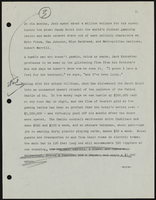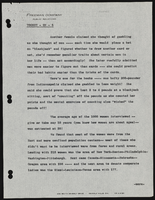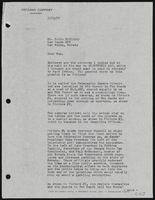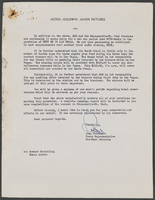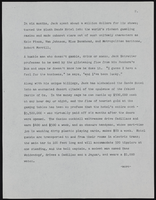Search the Special Collections and Archives Portal
Search Results

Transcript of interview with Joseph L. Haughaboo by James F. Haughaboo, April 1, 1976
Date
Archival Collection
Description
On April 1, 1976, James F. Haughaboo interviewed his father, Joseph L. Haughaboo in his father’s home at 954 Lulu Avenue, Las Vegas, Nevada. The two discuss Haughaboo’s personal family history, his occupational history, and Mr. Haughaboo’s observations of Las Vegas city life since he moved to the state in 1953.
Text
Ruth Moore Weaver oral history interview
Identifier
Abstract
Oral history interview with Ruth Moore Weaver conducted by her grandson, Danny Weaver, on November 22, 1986 for the Ralph Roske Oral History Project on Early Las Vegas. In this interview, Weaver begins by discussing her early life and family history. Weaver describes how Las Vegas, Nevada has developed and changed, as well her and her husband's participation in community organizations. She talks about her husband's jobs, how she prefers living in Southern Nevada compared to other areas, and segregation in the city. Weaver concludes by discussing why she prefers to live in Henderson, Nevada and the history of gambling in Nevada.
Archival Collection

Transcript of interview with Helen M. Clark by Danny Winegar, March 5, 1979
Date
Archival Collection
Description
Text
Lottery Enterprises Incorporated Records
Identifier
Abstract
The collection contains press releases and press kits from Lottery Enterprises Incorporated, a San Diego, California company that produces vending machines for lottery instant tickets. The records date from 1993.
Archival Collection
Mary R. Stout oral history interview
Identifier
Abstract
Oral history interview with Mary R. Stout conducted by Greg Rowland on February 20, 1980 for the Ralph Roske Oral History Project on Early Las Vegas. In this interview, Stout discusses her personal history and living in Boulder City, Nevada. Stout describes living in "Ragtown," a makeshift settlement for workers constructing Hoover Dam (Boulder Dam) before Boulder City was established. She also describes her father's duties as a pipe fitter while working on the construction of Hoover Dam (Boulder Dam) and how Boulder City has changed and evolved. Stout concludes by talking about nuclear weapons tests, her careers, and gambling in Boulder City.
Archival Collection

